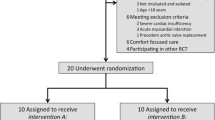Abstract
Background
Fever in neurocritical care patients is common and has a negative impact on neurological outcome. The purpose of this prospective observational study was (1) to evaluate the practicability of cooling with newly developed neck pads in the daily setting of neurointensive care unit (NICU) patients and (2) to evaluate its effectiveness as a surrogate endpoint to indicate the feasibility of neck cooling as a new method for intractable fever.
Methods
Nine patients with ten episodes of intractable fever and aneurysmal subarachnoid hemorrhage were treated with one of two different shapes of specifically adapted cooling neck pads. Temperature values of the brain, blood, and urinary bladder were taken close meshed after application of the cooling neck pads up to hour 8.
Results
The brain, blood, and urinary bladder temperatures decreased significantly from hour 0 to a minimum in hour 5 (P < 0.01). After hour 5, instead of continuous cooling in all the patients, the temperature of all the three sites remounted.
Conclusion
This study showed the practicability of local cooling for intractable fever using the newly developed neck pads in the daily setting of NICU patients.



Similar content being viewed by others
References
Badjatia N. Hyperthermia and fever control in brain injury. Crit Care Med. 2009;37:250–7.
Mayer SA, Kowalski RG, Presciutti M, et al. Clinical trial of a novel surface cooling system for fever control in neurocritical care patients. Crit Care Med. 2004;32:2508–15.
Wang CX, Stroink A, Casto JM, Kattner K. Hyperthermia exacerbates ischaemic brain injury. Int J Stroke. 2009;4:274–84.
Oliveira-Filho J, Ezzeddine MA, Segal AZ, et al. Fever in subarachnoid hemorrhage: relationship to vasospasm and outcome. Neurology. 2001;56:1299–304.
Commichau C, Scarmeas N, Mayer SA. Risk factors for fever in the neurologic intensive care unit. Neurology. 2003;60:837–41.
Diringer MN, Reaven NL, Funk SE, Uman GC. Elevated body temperature independently contributes to increased length of stay in neurologic intensive care unit patients. Crit Care Med. 2004;32:1489–95.
Laupland KB. Fever in the critically ill medical patient. Crit Care Med. 2009;37:273–8.
Benarroch EE. Thermoregulation: recent concepts and remaining questions. Neurology. 2007;69:1293–7.
Morrison SF, Nakamura K, Madden CJ. Central control of thermogenesis in mammals. Exp Physiol. 2008;93:773–97.
Wright CL, Burgoon PW, Bishop GA, Boulant JA. Cyclic GMP alters the firing rate and thermosensitivity of hypothalamic neurons. Am J Physiol Regul Integr Comp Physiol. 2008;294:1704–15.
Yoshida K, Li X, Cano G, Lazarus M, Saper CB. Parallel preoptic pathways for thermoregulation. J Neurosci. 2009;29:11954–64.
Nelson DA, Nunneley SA. Brain temperature and limits on transcranial cooling in humans: quantitative modeling results. Eur J Appl Physiol Occup Physiol. 1998;78:353–9.
Keller E, Mudra R, Gugl C, Seule M, Mink S, Frohlich J. Theoretical evaluations of therapeutic systemic and local cerebral hypothermia. J Neurosci Methods. 2009;178:345–9.
Zhu L, Diao C. Theoretical simulation of temperature distribution in the brain during mild hypothermia treatment for brain injury. Med Biol Eng Comput. 2001;39:681–7.
Bommadevara M, Zhu L. Temperature difference between the body core and arterial blood supplied to the brain during hyperthermia or hypothermia in humans. Biomech Model Mechanobiol. 2002;1:137–49.
English MJ, Hemmerling TM. Heat transfer coefficient: Medivance Arctic Sun Temperature Management System vs. water immersion. Eur J Anaesthesiol. 2008;25:531–7.
Lerch C, Yonekawa Y, Muroi C, Bjeljac M, Keller E. Specialized neurocritical care, severity grade, and outcome of patients with aneurysmal subarachnoid hemorrhage. Neurocrit Care. 2006;5:85–92.
Badjatia N, Strongilis E, Prescutti M, et al. Metabolic benefits of surface counter warming during therapeutic temperature modulation. Crit Care Med. 2009;37:1893–7.
Broom M. Physiology of fever. Paediatr Nurs. 2007;19:40–4.
Cabanac M. Selective brain cooling and thermoregulatory set-point. J Basic Clin Physiol Pharmacol. 1998;9:3–13.
Biddle C. The neurobiology of the human febrile response. AANA J. 2006;74:145–50.
Kiyatkin EA. Brain temperature fluctuations during physiological and pathological conditions. Eur J Appl Physiol. 2007;101:3–17.
Brengelmann GL. Specialized brain cooling in humans? FASEB J. 1993;7:1148–52; discussion 1152–3.
Sukstanskii AL, Yablonskiy DA. Theoretical limits on brain cooling by external head cooling devices. Eur J Appl Physiol. 2007;101:41–9.
Seder DB, Van der Kloot TE. Methods of cooling: practical aspects of therapeutic temperature management. Crit Care Med. 2009;37:211–22.
Corrard F. Selective brain cooling. Arch Pediatr. 1999;6:87–92.
Hachimi-Idrissi S, Corne L, Ebinger G, Michotte Y, Huyghens L. Mild hypothermia induced by a helmet device: a clinical feasibility study. Resuscitation. 2001;51:275–81.
Wang H, Olivero W, Lanzino G, et al. Rapid and selective cerebral hypothermia achieved using a cooling helmet. J Neurosurg. 2004;100:272–7.
Liu WG, Qiu WS, Zhang Y, Wang WM, Lu F, Yang XF. Effects of selective brain cooling in patients with severe traumatic brain injury: a preliminary study. J Int Med Res. 2006;34:58–64.
Qiu W, Shen H, Zhang Y, et al. Noninvasive selective brain cooling by head and neck cooling is protective in severe traumatic brain injury. J Clin Neurosci. 2006;13:995–1000.
Storm C, Schefold JC, Kerner T, et al. Prehospital cooling with hypothermia caps (PreCoCa): a feasibility study. Clin Res Cardiol. 2008;97:768–72.
Zhu L. Theoretical evaluation of contributions of heat conduction and countercurrent heat exchange in selective brain cooling in humans. Ann Biomed Eng. 2000;28:269–77.
Wang Y, Zhu L. Targeted brain hypothermia induced by an interstitial cooling device in human neck: theoretical analyses. Eur J Appl Physiol. 2007;101:31–40.
Acknowledgments
The project was supported by the GEBERT-RÜF foundation.
Author information
Authors and Affiliations
Corresponding author
Rights and permissions
About this article
Cite this article
Mink, S., Schwarz, U., Mudra, R. et al. Treatment of Resistant Fever: New Method of Local Cerebral Cooling. Neurocrit Care 15, 107–112 (2011). https://doi.org/10.1007/s12028-010-9451-1
Published:
Issue Date:
DOI: https://doi.org/10.1007/s12028-010-9451-1




